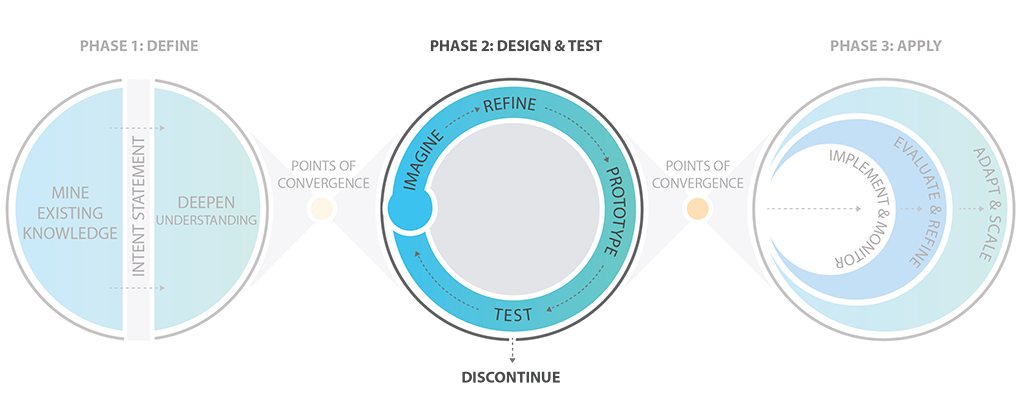Imagine

Sierra Leone, Design & Test
During the Design & Test Phase, Flow Chart users translate problems into solutions using a highly creative, collaborative, energetic, and human-centered approach. Using the insights and opportunities identified during the Define Phase as inspiration, groups of designers, health experts, development specialists, stakeholders, and representatives from the audience come together to rapidly generate a broad array of ideas for possible solutions. Users iteratively refine, prototype, and test these ideas several times in increasing levels of fidelity, using user feedback to inform the final solutions and ensure that they are both useful and usable for those involved in the design.

Imagine
How do we come up with creative ideas?
By the end of this step, you will have as many ideas generated as possible (ideation) from a diverse range of individuals, embracing out of the box thinking to find innovative ideas/solutions through an imagine workshop.
How to conduct this step and achieve its main objectives:
Craft “How Might We?” Questions
Crafting “How Might We? (HMW) questions means creating open-ended, user-centered queries to inspire innovative solutions. These questions help you uncover opportunities, challenges, and drive creative problem-solving within a specific context. Framing questions with HMW focuses your brainstorming and collaborative exploration of potential solutions.
HMW Question Template
Suggested time:
3–4 hours
Participants:
Design and research team
Tool: HMW Question Template
The HMW question template is a tool for transforming challenges or problems into openings for creative problem-solving. By structuring questions with the phrase “How Might We?” it stimulates brainstorming and ideation by directing attention to potential solutions instead of fixating on the problem itself. Discover how to craft your own using this template.
Effort required:

Generate Ideas
During this step, your creativity comes to life through brainstorming and developing new ideas, solutions, and perspectives. It involves exploring various angles, questioning assumptions, and thinking innovatively to find fresh and effective ways to address problems.
Brainstorming Template
Suggested time:
2–3 hours
Participants:
Design and research team, partners and
stakeholders, individuals you are designing for
Tool: Brainstorming Template
Brainstorming is an effective strategy for swiftly generating a multitude of ideas aimed at addressing specific challenges. It is most often conducted within a group setting, where participants freely and openly exchange their thoughts and suggestions without criticism. This template provides key principles and guidelines for successful brainstorming sessions.
Effort required:

Existing Solutions Bucket Template
Suggested time:
2–3 hours
Participants:
Design and research team, partners and
stakeholders, individuals you are designing for
Tool: Existing Solutions Bucket Template
Great ideas can emerge from various sources. The template allows you to refine existing ideas to test in your context and to delve into critical analysis and leveraging feedback loops. Use this tool to uncover hidden potentials, identify gaps, and fuse concepts for a superior solution.
Effort required:

Prioritize Ideas
This vital step involves careful evaluation and ranking of ideas, weighing their potential value and feasibility. Through this process, you identify the most promising ideas to pursue, setting aside others for future consideration.
Impact Effort Matrix Template
Suggested time:
2–3 hours
Participants:
Design and research team, partners and
stakeholders, individuals you are designing
for
Tool: Impact Effort Matrix Template
The impact effort matrix, a potent decision-making tool, evaluates ideas by considering their potential impact and the effort needed for execution. This tool involves plotting items on a grid to facilitate the prioritization of ideas and concepts. Tasks falling in the high impact, low effort quadrant represent quick wins, while those in the high impact, high effort category necessitate strategic planning. This matrix greatly assists in the efficient allocation of resources and decision making.
Effort required:

